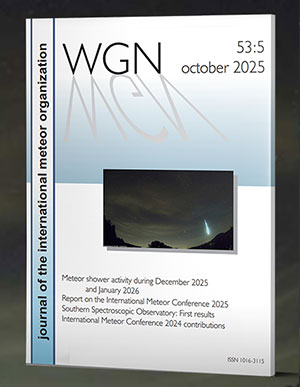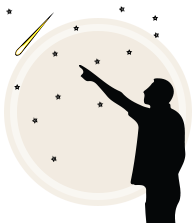After several months of low activity the meteor
rates for both hemispheres see a marked increase in July. In the northern hemisphere
the change is not noticeable until mid-month when several southern radiants, the
Perseids, and sporadic rates all increase in activity. Southern rates are good
all month long.
During this period the moon reaches its new phase
on Wednesday July 22nd. At this time it will lie near the sun and will be invisible
at night. The estimated total
hourly rates for evening observers this week is near four as seen from the northern
hemisphere and five for those situated south of the equator. For morning observers
the estimated total hourly rates should be near sixteen for those located in the
mid-northern hemisphere (45 N) and twenty two for those viewing from the mid-southern
hemisphere (45 S). Locations between these two extremes would see activity between
the listed figures. These rates assume that you are watching from rural areas away
from all sources of light pollution. The actual rates will also depend on factors
such as personal light and motion perception, local weather conditions, alertness
and experience in watching meteor activity.
The radiant positions and rates listed below are exact
for Saturday night/Sunday morning July 18/19. These positions do not change greatly
day to day so the listed coordinates may be used during this entire period. Most
star atlases (available at science stores and planetariums) will provide maps
with grid lines of the celestial coordinates so that you may find out exactly
where these positions are located in the sky. A planisphere or computer planetarium
program is also useful in showing the sky at any time of night on any date of the
year. Activity from each radiant is best seen when it is positioned highest in the
sky, either due north or south along the meridian, depending on your latitude. It
must be remembered that meteor activity is rarely seen at the radiant position.
Rather they shoot outwards from the radiant so it is best to center your field of
view so that the radiant lies at the edge and not the center. Viewing there will
allow you to easily trace the path of each meteor back to the radiant (if it is
a shower member) or in another direction if it is a sporadic. Meteor activity is
not seen from radiants that are located below the horizon. The positions below
are listed in a west to east manner in order of right ascension (celestial longitude).
The positions listed first are located further west therefore are accessible earlier
in the night while those listed further down the list rise later in the night.
The following showers are expected to be active this week:
The Alpha Capricornids (CAP) are active from a wide radiant located at
19:52 (298) -12. This position lies in extreme northeastern Sagittarius, five
degrees west of the third magnitude double star Alpha Capricornii. The radiant is
best placed near 0100 local daylight time (LDT), when it lies on the meridian and
is highest in the sky. Current rates would be near one per hour, no matter
your location. Don’t confuse these meteors with the more numerous antihelion
meteors, which have a radiant just to the east. Both radiants need to be in
your field of view to properly sort these meteors. With an entry velocity of
24 km/sec., most activity from this radiant would be slow, a bit slower than
the antihelions. This radiant is well seen except for far northern latitudes
where it remains twilight all night long and the radiant does not rise as
high into their sky.
The large Antihelion (ANT) radiant is now centered at 20:36 (309) -17.
This area of the sky lies in western Capricornus, five degrees southeast of the
third magnitude star Beta Capricornii. Actually any meteor from Capricornus,
southeastern Aquila, southwestern Aquarius, as well as eastern Sagittarius could
be a candidate for this shower. This radiant is best placed near 0200 LDT when it
lies on the meridian and is highest in the sky. Rates at this time should be
near two for northern observers and three for observers south of the
equator. With an entry velocity of 30 km/sec., the average Antihelion meteor
would be of medium-slow speed.
Studies by Sirko Molau of the IMO’s video data has revealed an active radiant
located in western Aquarius this time of year. The radiant lies at 21:32 (323)
-03, which is located three degrees north of the third magnitude star Sadalsuud
(Beta Aquarii). This radiant is best placed near 0300 LDT when it lies on the
meridian and is highest in the sky. Rates are most likely less than one per hour
regardless of your location. Maximum activity occurred on July 6th. With an entry
velocity of 40 km/sec., the average North June Aquilid (NZC) meteor would
be of medium speed, but noticeably more swift than the nearby Antihelion radiant.
The Delta Aquariids (SDA) become active next week with rates of 1-2 per
hour. The radiant is located at 22:12 (333) -18. This position lies in southwestern
Aquarius, ten degrees west of the third magnitude star Delta Aquarii. The radiant
is best placed near 0300 LDT, when it lies highest in the sky. The optimal
latitudes for viewing this shower lie in the southern tropics where the radiant
passes overhead. With an entry velocity of 43 km/sec., most activity from this
radiant would be of average velocities. These meteors tend to be faint so the
darkest skies are necessary in order to see this shower well.
The Pisces Austrinids (PAU) is a weak shower with a radiant is located at
22:16 (334) -33. This area of the sky lies in southern Piscis Austrinus, twelve
degrees southwest of the bright star Fomalhaut (Alpha Piscis Austrini). These
meteors are best seen near 0300 LDT, when the radiant lies highest above the
horizon. One can expect rates near one per hour from the southern
hemisphere and less than one from the north. At 35/km per second, these meteors
are of average velocity, slower than the Aquariids but faster than the Alpha
Caps and the antihelion meteors.
The Perseids (PER) are now active from a radiant located at 00:40 (010)
+52. This position lies in southern Cassiopeia, five degrees south of the second
magnitude star Shedar (Alpha Cassiopeiae). The radiant is best placed during the
last hour before the start of morning twilight when it lies highest in a dark sky.
Current rates would be less than one to two hour, as seen from the northern
hemisphere. Activity from this source is not visible south of 40 degrees south
latitude. With an entry velocity of 59 km/sec., most activity from this
radiant would be swift.
As seen from the mid-northern hemisphere (45N) one would expect to see approximately
ten Sporadic meteors per hour during the last hour before dawn as seen
from rural observing sites. Evening rates would be near three per hour. As seen from
the mid-southern hemisphere (45S), morning rates would be near fifteen per hour as
seen from rural observing sites and four per hour during the evening hours. Locations
between these two extremes would see activity between the listed figures.
The table below presents a summary of the expected activity this week. Rates and
positions are exact for Saturday night/Sunday morning but may be used all week.
| SHOWER | DATE OF MAXIMUM ACTIVITY | CELESTIAL POSITION | ENTRY VELOCITY | CULMINATION | HOURLY RATE | CLASS* | RA (RA in Deg.) DEC | Km/Sec | Local Daylight Time | North-South | Alpha Capricornids (CAP) | Jul 28 | 19:52 (298) -12 | 24 | 01:00 | 1 – 1 | II | Antihelions (ANT) | – | 20:36 (309) -17 | 30 | 02:00 | 2 – 3 | II | North June Aquilids (NZC) | Jul 06 | 21:32 (323) -03 | 43 | 03:00 | <1 - <1 | IV | Delta Aquariids (SDA) | Jul 30 | 22:12 (333) -18 | 43 | 03:30 | 1 – 1 | I | Pisces Austrinids (PAU) | Jul 28 | 22:16 (334) -33 | 35 | 03:30 | <1 - 1 | I | Perseids (PER) | Aug 12 | 00:40 (010) +52 | 59 | 07:00 | 2 – 1 | I |




 You saw something bright and fast? Like a huge shooting star? Report it: it may be a fireball.
You saw something bright and fast? Like a huge shooting star? Report it: it may be a fireball.  You counted meteors last night? Share your results with us!
You counted meteors last night? Share your results with us!  You took a photo of a meteor or fireball? You have a screenshot of your cam? Share it with us!
You took a photo of a meteor or fireball? You have a screenshot of your cam? Share it with us!  You caught a meteor or fireball on video? Share your video with us!
You caught a meteor or fireball on video? Share your video with us!